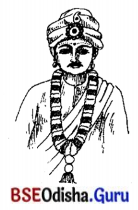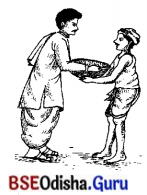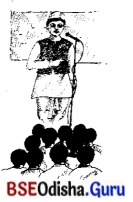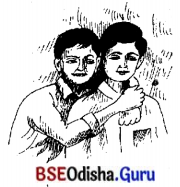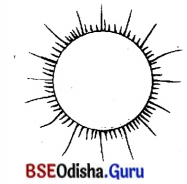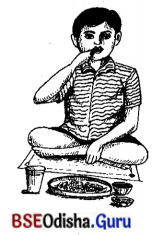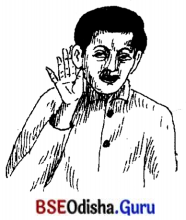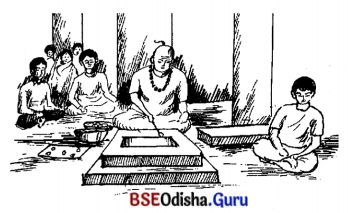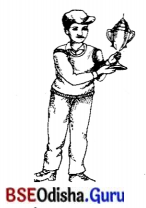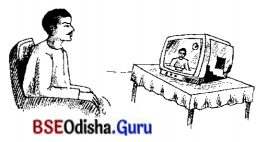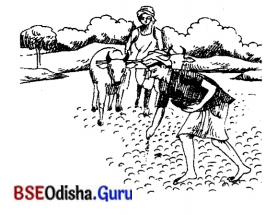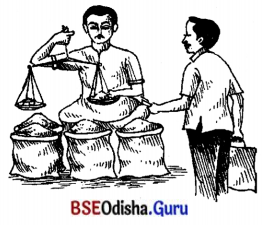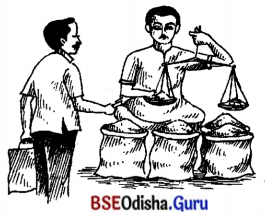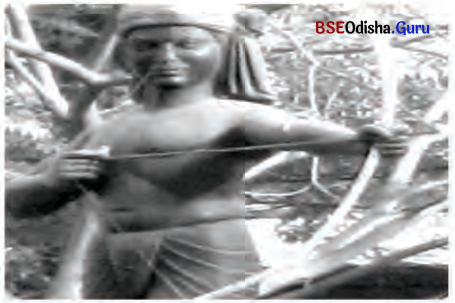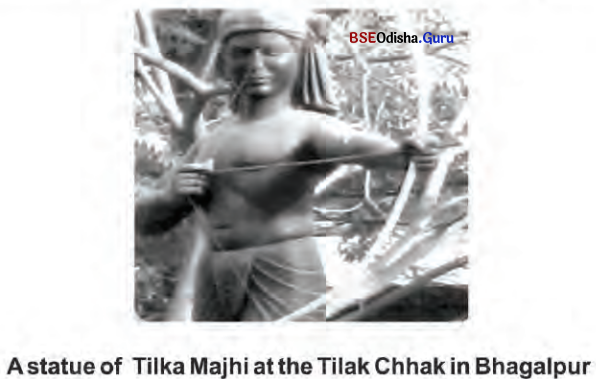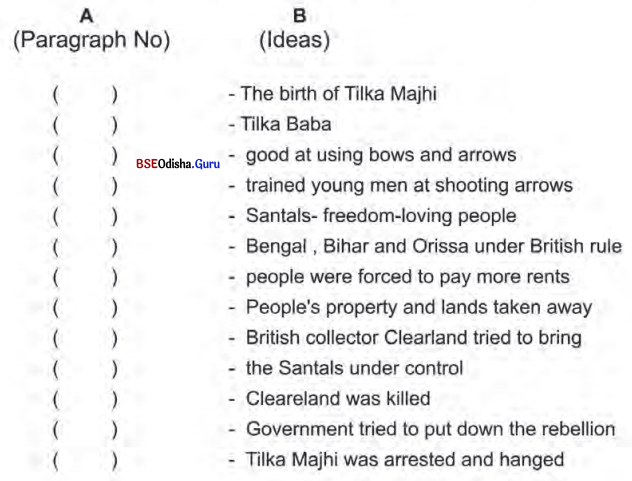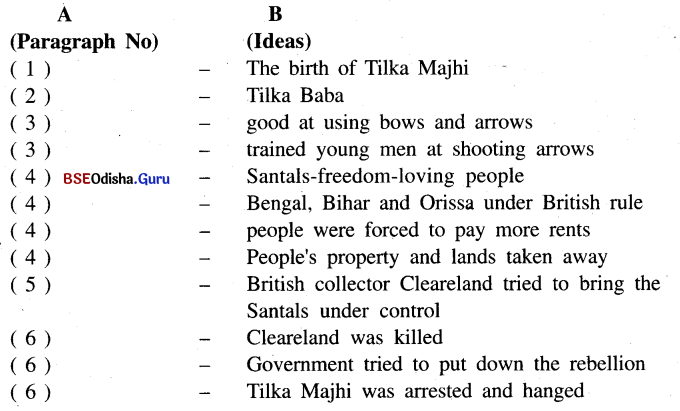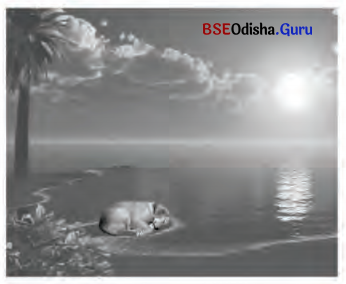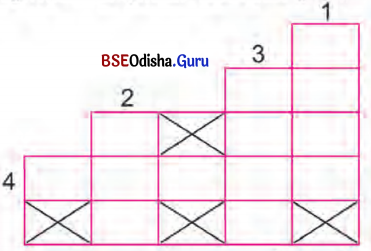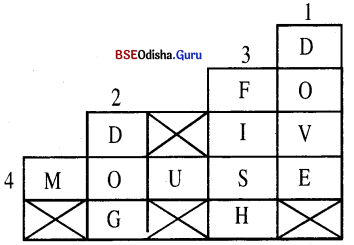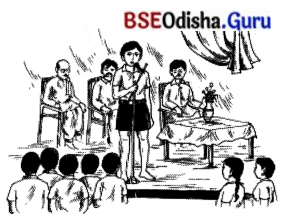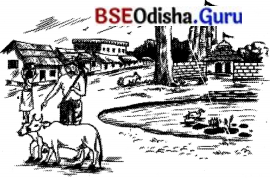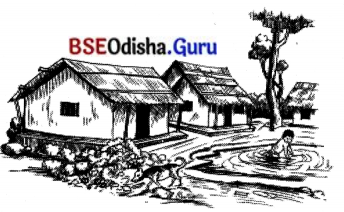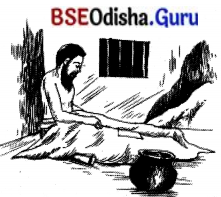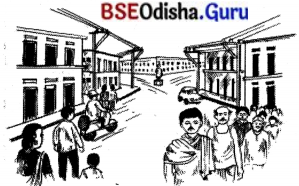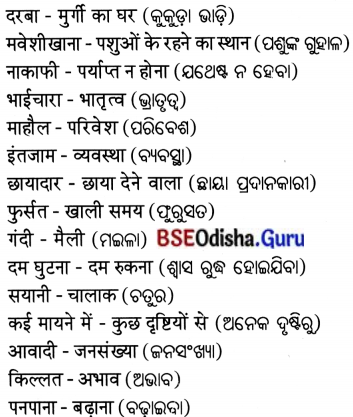Odisha State Board BSE Odisha 7th Class Geography Important Questions Chapter 7 ପାରିବେଶିକ ପ୍ରଭାବ ଓ ଅଧିବାସୀଙ୍କ ଜୀବନ ଜୀବିକା Important Questions and Answers.
BE Odisha Class 7 Geography Important Questions Chapter 7 ପାରିବେଶିକ ପ୍ରଭାବ ଓ ଅଧିବାସୀଙ୍କ ଜୀବନ ଜୀବିକା
Subjective Type Questions With Answers
ଦୀର୍ଘ ଉତ୍ତରମୂଳକ ପ୍ରଶ୍ନୋତ୍ତର
Question 1.
ଆମାଜନ ଅବବାହିକାର ଜଳବାୟୁ, ଉଭିଦ ଓ ଜୀବଜନ୍ତୁ ସମ୍ପର୍କରେ ଆଲୋଚନା କର ।
Answer:
ଜଳବାୟୁ :
- ଆମାଜନ ନଦୀ ବିଷୁବମଣ୍ଡଳ ଦେଇ ପ୍ରବାହିତ ହୋଇଥିବାରୁ ଏହାର ଅବବାହିକାର ଜଳବାୟୁ ଉଷ୍ଣ ଓ ଆର୍ଦ୍ର ।
- ଏହି ଅଞ୍ଚଳରେ ପ୍ରତିଦିନ ଅପରାହ୍ନରେ ପ୍ରଚୁର ବୃଷ୍ଟିପାତ ହୋଇଥାଏ ।
- ଏଠାରେ ବିଶେଷ ଶୀତ ଅନୁଭୂତ ହୁଏ ନାହିଁ ।
ଉଦ୍ଭିଦ :
- ମେହୋଗାନି, ଆବୁଲସ୍, ଡାଳ, ରବର ଆଦି ବୃକ୍ଷ ଥିବା ଚିରହରିତ୍ ଅରଣ୍ୟ ଏହି ଅଞ୍ଚଳରେ ଦେଖାଯାଏ ।
- ଏଠାକାର ଅରଣ୍ୟ ଘଞ୍ଚ, ଭୂମି ସନ୍ତସନ୍ତିଆ ଓ ଏଠାକାର ଭୂମି ଉପରେ ଖରା ପଡ଼ୁ ନଥିବାରୁ ଛାଇରେ ବଢ଼ିପାରୁଥିବା, ପତ୍ର ନଥୁବା ବିଭିନ୍ନ ପ୍ରକାର ଅର୍କିଡ୍ ଓ କେତେକ ଲତା ଜାତୀୟ ପରାଙ୍ଗପୁଷ୍ଟ ଉଦ୍ଭଦ ଦେଖାଯାନ୍ତି ।
ଜୀବଜନ୍ତୁ :
- ଏହି ଅଞ୍ଚଳ ମାଙ୍କଡ଼, ଉଇଖୁଆ ଟାପିର୍, ସୁଥ୍ ଆଦି ବିଭିନ୍ନ ପ୍ରାଣୀ, ବିଭିନ୍ନ ପ୍ରଜାତିର ସାପ, ସରୀସୃପ ଓ କୁମ୍ଭୀର ଆଦିଙ୍କ ବାସସ୍ଥଳୀ ।
- ଆନାକୋଣ୍ଡା ଏବଂ ବୋଆ ଜାତୀୟ ଭୟଙ୍କର ସାପ, ମାଂସ ପିରାନା ମାଛ, ହଜାର ହଜାର ଜାତିର କୀଟପତଙ୍ଗ ଏଠାରେ ଦୃଷ୍ଟିଗୋଚର ହୁଅନ୍ତି ।
- ବିଭିନ୍ନ ଜାତିର ଅଦ୍ଭୁତ ପକ୍ଷୀ, ଯଥା- ଟଉକାନ୍, ନାନା ଜାତିର ରଙ୍ଗିନ ପରଯୁକ୍ତ ପକ୍ଷୀ ଏହି ଅରଣ୍ୟରେ ବାସ କରନ୍ତି ।

Question 2.
ଉଷ୍ଣ ମରୁ ଅଞ୍ଚଳର ଜଳବାୟୁ, ଉଭିଦ ଓ ଜୀବଜନ୍ତୁମାନଙ୍କର ବିଶେଷତ୍ଵଗୁଡ଼ିକ ଲେଖ ।
Answer:
ଜଳବାୟୁ :
- ଉଷ୍ଣ ମରୁଭୂମି ଅଞ୍ଚଳରେ ତାପମାତ୍ରାର ଆଧିକ୍ୟ ଓ ସ୍ଵଳ୍ପ ବୃଷ୍ଟିପାତ ଯୋଗୁ ଏହାର ଜଳବାୟୁ ଉଷ୍ଣ ଓ ଶୁଷ୍କ ।
- ଦିନବେଳା ଅଧିକ ଗରମ ଓ ରାତିରେ ଅଧିକ ଶୀତ ହୁଏ ।
ଉଦ୍ଭବ :
- ଏହି ଅଞ୍ଚଳରେ ବାଷ୍ପୀଭବନ ତୀବ୍ର ହୋଇଥାଏ, ତେଣୁ ଏହାର ମୃରିକା ଲୁଣିଆ ଓ ବାୟୁ ଶୁଷ୍କ ଥାଏ ।
- ଏଠାରେ କଣ୍ଟାଜାତୀୟ ଗୁଳ୍ମ ତଥା କାକ୍ସ, ଶିଳ୍ପ, ନାଗଫେଣୀ ଆଦି ମରୁଜାତୀୟ ଉଦ୍ଭଦ ଦେଖାଯାଏ ।
- ମରୂଦ୍ୟାନ ଅଞ୍ଚଳରେ ଖଜୁରୀ, ତାଳ, ଆକାଶିଆ ଗଛ ବଢ଼ିଥାଏ ।
ଜଳବାୟୁ :
- ଓଟ ଏ ଅଞ୍ଚଳର ମୁଖ୍ୟ ପଶୁ ।
- ଏହା ବ୍ୟତୀତ ବିଲୁଆ, କୋକିଶିଆଳି, ହାଏନା ଆଦି ମାଂସାଶୀ ପ୍ରାଣୀ, କଙ୍କଡ଼ାବିଛା, ଝିଟିପିଟି, ସାପ ଆଦି ସରୀସୃପ ଅଞ୍ଚଳରେ ବହୁଳ ସଂଖ୍ୟାରେ ଦେଖାଯାନ୍ତି ।’
Question 3.
ଶୀତଳ ମରୁଭୂମି ଅଞ୍ଚଳର ଜଳବାୟୁ ଉଦ୍ଭିଦ ଓ ଜୀବତ ସମ୍ପର୍କରେ ଲେଖ ।
Answer:
- ଲାଦାଖ ଏକ ଶୀତଳ ମରୁଭୂମି। ଏହାର୍ଗ ଜଳବାୟୁ ଅତ୍ୟଧିକ ଥଣ୍ଡା ଓ ଶୁଷ୍କ ।
- ଏଠାରେ ଗ୍ରୀଷ୍ମ ଋତୁରେ ଦିନର ତାପମାତ୍ରା ୦° ସେଲସିଅସ୍ରୁ ସାମାନ୍ୟ ଉପରେ ଥାଏ ଓ ରାତିରେ ତାପମାତ୍ରା –୩୦° ସେଲ୍ସିଅସ୍ ପର୍ଯ୍ୟନ୍ତ ଖସିଆସେ । ଶୀତଋତୁରେ ତାପମାତ୍ରା ପ୍ରାୟତଃ —୪୦° ସେଲସିଅସ୍ ରହିଥାଏ।
- ଭୂମି ବରଫଦ୍ଵାରା ଆଚ୍ଛାଦିତ ଥିବାରୁ ଏହି ଅଞ୍ଚଳରେ ପ୍ରାୟ ବୃକ୍ଷଶୂନ୍ୟ ଥାଏ। କେତେକ ସ୍ଥାନରେ ସ୍ପୃଶ୍ ଓ ଓକ୍ ଜାତୀୟ ଉଭିଦ ଦେଖାଯାଏ। ଗ୍ରୀଷ୍ମଦିନେ ବରଫ ସାମାନ୍ୟ ତରଳିବାରୁ ସେଓ, ନାସ୍ପାତି ପ୍ରଭୃତି ବୃକ୍ଷ ଫୁଲଫଳ ଧାରଣ କରେ।
- ଏଠାରେ ବଣୁଆ ଛେଳି, ମେଣ୍ଢା, ଗାଈ ଏବଂ ଏକ ଭିନ୍ନ ଧରଣର ବଣୁଆ କୁକୁର ଦେଖାଯାଏ। ରବିନ୍, ତିବ୍ବତୀୟ ତୁଷାର କୁକୁଡ଼ା ଭଳି ବହୁ ସୁନ୍ଦର ଓ ମୂଲ୍ୟବାନ୍ ପକ୍ଷୀ ଦୃଷ୍ଟିଗୋଚର ହୁଏ।
- ଲୋକମାନେ ବଣ୍ୟ ଛେଳି, ମେଣ୍ଢା ଓ ଚମରୀ ଗାଈ ପାଳନ କରନ୍ତି ।
ସଂକ୍ଷିପ୍ତ ଉତ୍ତରମୂଳକ ପ୍ରଶ୍ନୋତ୍ତର
Question 1.
ଆମାଜନ ଅବବାହିକାର ଅଧିବାସୀମାନଙ୍କ କୃଷି ସମ୍ପର୍କରେ ଲେଖ ।
Answer:
- ଆମାଜନ ଅବବାହିକାର ଅଧ୍ଵବାସୀମାନେ ସ୍ଥାନାନ୍ତରିତ କୃଷି ପ୍ରଣାଳୀରେ ଚାଷ କରିଥା’ନ୍ତି ।
- ସେମାନେ କଦଳୀ, ସପୁରି, ମିଠାଆଳୁ ବା କାସାରା ଏବଂ ଟୋପିଆକା ଆଦି ଚାଷ କରିଥା’ନ୍ତି ।
Question 2.
ଆମାଜନ ଅବବାହିକାର ଘଞ୍ଚ ଅରଣ୍ୟର ପରିମାଣ ହ୍ରାସ ପାଉଛି କାହିଁକି ?
Answer:
- ଘଞ୍ଚ ଜଙ୍ଗଲ ହେତୁ ଏହାର ଶିଳ୍ପ ଉତ୍ପାଦନ ନିମିତ୍ତ କେତେକ ଅରଣ୍ୟଲବ୍ଧ ଦ୍ରବ୍ୟ ଓ କାଷ୍ଠ ସମ୍ବଳ ଉପରେ ନିର୍ଭରଶୀଳ ।
- କାଷ୍ଠଭିତ୍ତିକ ଶିଳ୍ପର ବୃଦ୍ଧି ଯୋଗୁ ଏଠାରେ ଅରଣ୍ୟର ପରିମାଣ କମି କମି ଯାଉଛି ।

Question 3.
ଗଙ୍ଗାନଦୀ ଦୂଷିତ ହେବାର କାରଣ ଲେଖ ।
Answer:
- ଗଙ୍ଗାନଦୀ ‘ ଅବବାହିକାରେ ଆଲ୍ଲାହାବାଦ, କାନପୁର, ବାରଣାସୀ, ଲକ୍ଷ୍ନୌ, କୋଲ୍କାତା ଭଳି ବଡ଼ ବଡ଼ ସହର ଅବସ୍ଥିତ । ଏଗୁଡ଼ିକରେ ଘନ ଜନବସତି ରହିଛି ।
- ଏହି ସହରମାନଙ୍କ ଶିଳ୍ପ କାରଖାନାରୁ ଆବର୍ଜନା ଓ ବିଷାକ୍ତ ପଦାର୍ଥ ନଦୀଜଳରେ ମିଶୁଛି ଓ ଘନ ଜନବସତି ଯୋଗୁ ଏ ଅଞ୍ଚଳର ପରିବେଶ ଦୂଷିତ ହେଉଛି ।
Question 4.
ଲାଦାଖ ମରୁଭୂମିର ଜଳବାୟୁ ଅବସ୍ଥା କିପରି ଉଲ୍ଲେଖ କର ।
Answer:
- ସମୁଦ୍ର ପତ୍ତନଠାରୁ ବହୁ ଉଚ୍ଚରେ ଥିବାରୁ ଲାଦାଖର ଜଳବାୟୁ ଅତ୍ୟଧିକ ଥଣ୍ଡା ଓ ଶୁଷ ।
- ଗ୍ରୀଷ୍ମକାଳରେ ଦିନର ତାପମାତ୍ରା ୦° ସେଲ୍ସିୟସରୁ ସାମାନ୍ୟ ଉଚ୍ଚରେ ଓ ଶୀତଦିନେ ତାପମାତ୍ରା ପ୍ରାୟତଃ —୪୦° ସେଲ୍ସିୟସ୍ ରହିଥାଏ ।
Question 5.
ସାହାରା ମରୁଭୂମି ଅଞ୍ଚଳ ଏକଦା ସମତଳ ଅଞ୍ଚଳ ଓ ଅରଣ୍ୟ ଆଚ୍ଛାଦିତ ଅଞ୍ଚଳ ଥିଲା – ଏହାର ପ୍ରମାଣ ଦିଅ ।
Answer:
- ସାହାରା ମରୁଭୂମିର ପାର୍ବତ୍ୟାଞ୍ଚଳରେ ଥିବା କେତେକ ଶିଳାଲିପିର ସନ୍ଧାନ ମିଳିଛି ।
- ଏଥରେ ନଦୀ, କୁମ୍ଭୀର, ଅରଣ୍ୟ, ହାତୀ, ସିଂହ, ଓଟ, ଜିରାଫ, ଛେଳି, ମେଣ୍ଢା ଆଦି ପଶୁମାନଙ୍କର ଚିତ୍ର ଦେଖିବାକୁ ମିଳୁଛି । ଏଥୁରୁ ପ୍ରମାଣ ମିଳେ ସାହାରା ଅଞ୍ଚଳ ଏକଦା ସମତଳ ଭୂମି ଓ ଅରଣ୍ୟ ଆଚ୍ଛାଦିତ ଅଞ୍ଚଳ ଥିଲା ।
Question 6.
ପୋଡୁଚାଷ କାହାକୁ କୁହାଯାଏ ?
Answer:
- ଓଡ଼ିଶାର ଆଦିବାସୀମାନେ କରୁଥିବା ସ୍ଥାନାନ୍ତରିତ କୃଷିକୁ ପୋଡୁଚାଷ କୁହାଯାଏ ।
- ସେମାନେ ଜଙ୍ଗଲର ଏକ ନିର୍ଦ୍ଦିଷ୍ଟ ଅଞ୍ଚଳ ସଫା କରି, ନିଆଁ ଲଗାଇ ସେଠାରେ ଚାଷ କରନ୍ତି । କିଛି ବର୍ଷ ପରେ ସେଠାରେ ଉର୍ବରତା କମିଗଲେ ଅରଣ୍ୟର ଅନ୍ୟ ସ୍ଥାନରେ ଚାଷ କରନ୍ତି । ପୁଣି କିଛି ବର୍ଷ ପରେ ପୂର୍ବ ସ୍ଥାନକୁ ଫେରିଆସି ଚାଷ କରିଥା’ନ୍ତି ।
Question 7.
ଲାଦାଖ ଶବ୍ଦ କିପରି ଉତ୍ପରି ହୋଇଛି ? ଏହାର ଅନ୍ୟନାମ କ’ଣ ?
Answer:
- ଲାଦାଖ ଶବ୍ଦଟି ‘ଲା’ ଏବଂ ‘ଦାକ୍’ ଶବ୍ଦକୁ ନେଇ ଗଠିତ । ‘ଲା’ ଶବ୍ଦର ଅର୍ଥ ଗିରିପଥ ଏବଂ ‘ଦାକ୍’ ଶବ୍ଦର ଅର୍ଥ ଦେଶ ।
- ଲାଦାଖର ଅନ୍ୟନାମ କାପା-ଚାନ୍ ବା ବରଫ ଭୂମି ।
Question 8.
ସାହାରା ଅଞ୍ଚଳରେ ରହୁଥିବା ଯାଯାବର ଶ୍ରେଣୀର ଅଧିବାସୀମାନେ କିପରି ଜୀବିକା ନିର୍ବାହ କରନ୍ତି ?
Answer:
- ସାହାରା ଅଞ୍ଚଳରେ ବେଦୁଇନ୍ ନାମକ ଯାଯାବର ଶ୍ରେଣୀର ଲୋକ ବାସ କରନ୍ତି । ସେମାନେ ଓଟ, ଗଧ, ଛେଳି, ମେଣ୍ଢା . ଆଦି ପଶୁ ପାଳନ କରନ୍ତି ।
- ଏହି ପଶୁମାନଙ୍କଠାରୁ ଏମାନେ ଦୁଗ୍ଧ, ଲୋମ ଓ ଚମଡ଼ା ସଂଗ୍ରହ କରି ଜୀବିକା ନିର୍ବାହ କରନ୍ତି ।
Question 9.
ଆମାଜନ ଅଞ୍ଚଳର ଜଳବାୟୁ ଉଷ୍ଣ ଓ ଆର୍ଦ୍ର କାହିଁକି ?
Answer:
- ଆମାଜନ ଅଞ୍ଚଳରେ ସୂର୍ଯ୍ୟକିରଣ ଭୂପୃଷ୍ଠ ଉପରେ ପଡୁଥିବାରୁ ଏଠାରେ ତାପମାତ୍ରା ଅଧିକ ହୋଇଥାଏ।
- ଏହି ଅଞ୍ଚଳରେ ପ୍ରାୟ ପ୍ରତିଦିନ ଅପରାହ୍ନରେ ପ୍ରଚୁର ବୃଷ୍ଟିପାତ ହୋଇଥାଏ, ତେଣୁ ଏହାର ଜଳବାୟୁ ଉଷ୍ଣ ଓ ଆର୍ଦ୍ର।

Question 10.
ଆମାଜନ ଅରଣ୍ୟରେ କେଉଁ ପ୍ରକାର ମାଛ ଓ ପକ୍ଷୀ ଦେଖାଯାଆନ୍ତି ?
Answer:
- ଆମାଜନ ଅରଣ୍ୟ ହଜାର ହଜାର ଜାତିର କୀଟପତଙ୍ଗ ଓ ମାଛଙ୍କର ଆଦିଭୂମି ଅଟେ। ମାଂସ ପିରାନା ମାଛ ଏହିଅଞ୍ଚଳର ଏକ ବିଶିଷ୍ଟ ମାଛ।
- ବିଭିନ୍ନ ଜାତିର ଅଦ୍ଭୁତ ପକ୍ଷୀ ଏଠାରେ ଦେଖାଯାଆନ୍ତି । ସେମାନଙ୍କ ମଧ୍ୟରେ ଟଉକାନ, ନାନା ଜାତିର ରଙ୍ଗିନ ପରଯୁକ୍ତ ପକ୍ଷୀ ଏହି ଅରଣ୍ୟରେ ବାସ କରନ୍ତି ।
Question 11.
ଗଙ୍ଗା ଓ ବ୍ରହ୍ମପୁତ୍ର ନଦୀରେ କେଉଁ ପ୍ରକାର ଡଲଫିନ୍ ଦେଖାଯାଏ ? ଡଲଫିନ୍ ତଥା ମଧୁର ମାଛମାନଙ୍କର ସଂଖ୍ୟା କାହିଁକି କମିବାରେ ଲାଗିଛି ?
Answer:
- ଗଙ୍ଗା ଓ ବ୍ରହ୍ମପୁତ୍ର ନଦୀର ଜଳରେ ଶୁଶୁ ନାମକ ଏକପ୍ରକାର ଡଲଫିନ୍ ଦେଖାଯାଆନ୍ତି ।
- କଳକାରଖାନାରୁ ନିର୍ଗତ ବିଷାକ୍ତ ଜଳ, ସହରମାନଙ୍କର ନର୍ଦମା ଜଳ ନଦୀରେ ମିଶି ଜଳକୁ ଦୂଷିତ କରୁଥିବାରୁ ଏହି ଡଲଫିନ୍ ତଥା ମଧୁର ମାଛମାନଙ୍କର ସଂଖ୍ୟା କମିବାରେ ଲାଗିଛି ।
Question 12.
ନାତିଶୀତୋଷ ମହାଦେଶୀୟ ଜଳବାୟୁ କହିଲେ କ’ଣ ବୁଝ ?
Answer:
- ଯେଉଁ ତୃଣଭୂମି ଅଞ୍ଚଳରେ ସାମୁଦ୍ରିକ ବାୟୁର ପ୍ରଭାବ ପଡ଼େ ନାହିଁ, ସେଠାରେ କେବଳ ଗ୍ରୀଷ୍ମ ଓ ଶୀତଋତୁ ଅନୁଭୂତ ହୁଏ ଏବଂ ବାର୍ଷିକ ହାରାହାରି ବୃଷ୍ଟିପାତ ପ୍ରାୟ ୫୦ ସେ.ମି. ହୋଇଥାଏ, ଏପ୍ରକାର ଜଳବାୟୁକୁ ନାତିଶୀତୋଷ୍ଣ ଜଳବାୟୁ କୁହାଯାଏ ।
- ଗ୍ରୀଷ୍ମଋତୁରେ ଅତ୍ୟଧିକ ଗରମ, ଶୀତଦିନରେ ଭୀଷଣ ଥଣ୍ଡା ଅନୁଭୂତ ହେବା ଏହି ଅଞ୍ଚଳର ଜଳବାୟୁର ଲକ୍ଷଣ।
Question 13.
ପ୍ରେରୀ ଅଞ୍ଚଳରୁ କାହିଁକି ବିଦେଶକୁ ଗହମ ରପ୍ତାନି କରାଯାଏ ?
Answer:
- ଉର୍ବର ମୃତ୍ତିକା ଓ ନାତିଶୀତୋଷ୍ଣ ମହାଦେଶୀୟ ଜଳବାୟୁ ଗହମ ଚାଷ ପାଇଁ ବିଶେଷ ଅନୁକୂଳ।
- ତେଣୁ ପ୍ରେରୀ ଅଞ୍ଚଳରେ ପ୍ରଚୁର ଗହମ ଚାଷ କରାଯାଏ ଓ ବିଦେଶକୁ ରପ୍ତାନି କରାଯାଏ।

Question 14.
ଉଦାହରଣ ସହ ଉଷ୍ଣ ମରୁଅଞ୍ଚଳ କାହାକୁ କହନ୍ତି ଲେଖ ।
Answer:
- ଭୂପୃଷ୍ଠର ଯେଉଁ ଅଞ୍ଚଳରେ ଚାରିଆଡ଼ ବାଲି, ପ୍ରବଳ ଖରା, ଅଳ୍ପବୃଷ୍ଟି ବା ବୃଷ୍ଟିହୀନ ଅଞ୍ଚଳ, ବୃକ୍ଷଲତାଶୂନ୍ୟ ତାହାକୁ ଉଷ୍ଣ ମରୁଅଞ୍ଚଳ କହନ୍ତି ।
- ଆମ ଦେଶର ଥର ଓ ଆଫ୍ରିକା ମହାଦେଶର ସାହାରା ମରୁଭୂମି ଉଷ୍ଣ ମରୁ ଅଞ୍ଚଳର ଉଦାହରଣ।
Question 15.
ଉଦାହରଣ ସହ ଶୀତଳ ମରୁଭୂମି କାହାକୁ କୁହାଯାଏ ଲେଖ
Answer:
- ଯେଉଁଠାରେ ଚାରିଆଡ଼ ପ୍ରବଳ ଥଣ୍ଡା ଓ ଭୂମି ବରଫାଚ୍ଛନ୍ନ ରହେ, ସେଠାରେ ଗଛଲତା ବଢ଼ିପାରେ ନାହିଁ, ସେହି ପ୍ରକାର ଅଞ୍ଚଳକୁ ଶୀତଳ ମରୁଭୂମି କୁହାଯାଏ।
- ଉଦାହରଣ- ଗ୍ରୀଲ୍ୟାଣ୍ଡ ଓ ତୁନ୍ଦ୍ରାଞ୍ଚଳ।
କାରଣ ଦର୍ଶାଅ
Question 1.
ଆମାଜନ ଅବବାହିକାରେ ଘନ ଜନବସତି ଦେଖାଯାଏ ନାହିଁ ।
Answer:
- ଆମାଜନ ଅବବାହିକା ବିଷୁବ ମଣ୍ଡଳୀୟ ଅଞ୍ଚଳରେ ଅବସ୍ଥିତ ।
- ବର୍ଷସାରା ପ୍ରବଳ ଖରା ଓ ବର୍ଷା ଯୋଗୁଁ ଏ ଅଞ୍ଚଳର ଜଳବାୟୁ ଅସହ୍ୟ ଓ ଅସ୍ଵାସ୍ଥ୍ୟକର । ଏଣୁ ଏହା ଘନ ଜନବସତି ପାଇଁ ଅନୁକୂଳ ନୁହେଁ ।
Question 2.
ନିରକ୍ଷୀୟ ଅଞ୍ଚଳର ଅରଣ୍ୟରେ ପରାଙ୍ଗପୁଷ୍ଟ ଲତା ଜାତୀୟ ଉଭିଦ ବେଶୀ ଦେଖାଯାଆନ୍ତି ।
Answer:
- ନିରକ୍ଷୀୟ ଅଞ୍ଚଳର ଅରଣ୍ୟ ଘଞ୍ଚ, ଭୂମି ସନ୍ତସନ୍ତିଆ ଏବଂ ଭୂମି ଉପରେ ପ୍ରାୟ ଖରା ପଡ଼ି ନଥାଏ ।
- ତେଣୁ ଛାଇରେ ବଢ଼ିପାରୁଥିବା କେତେକ ଲତା ଜାତୀୟ ପରାଙ୍ଗପୁଷ୍ଟ ଉଭିଦ ଅନ୍ୟ ଉଦ୍ଭଦକୁ ଆଶ୍ରା କରି ବଢ଼ିଥାଆନ୍ତି ।

Question 3.
ନଦୀ ପାର୍ବତ୍ୟାଞ୍ଚଳରେ ପ୍ରବାହିତ ହେଉଥିବାବେଳେ ତା’ର ସ୍ରୋତ ପ୍ରଖର ଥାଏ ।
Answer:
- ପାର୍ବତ୍ୟାଞ୍ଚଳର ଭୂମି ପଥୁରିଆ ଓ ଗଡ଼ାଣିଆ ହୋଇଥାଏ ।
- ନଦୀ ଗଡ଼ାଣିଆ ଭୂମିରେ ପ୍ରବାହିତ ହେବାବେଳେ ଏହା ସ୍ରୋତ ପ୍ରଖର ହୋଇଥାଏ ।
Question 4.
ଲାଦାଖ ଅଞ୍ଚଳରେ ପ୍ରାୟ ତୃଣଭୂମି ଦେଖାଯାଏ ନାହିଁ । ।
Answer:
- ଆମ ଦେଶର ଉତ୍ତର ଭାଗରେ ଥିବା ଲାଦାଖ ସମୁଦ୍ର ପତ୍ତନଠାରୁ ସର୍ବନିମ୍ନ ୩ କି.ମି. ଓ ସର୍ବାଧିକ ୮ କି.ମି. ଉଚ୍ଚତା ମଧ୍ଯରେ ଅବସ୍ଥିତ । ତେଣୁ ଏତେ ଉଚ୍ଚରେ ଥିବାରୁ ଏହାର ଜଳବାୟୁ ଅତ୍ୟଧିକ ଥଣ୍ଡା ଓ ଶୁଷ୍କ ।
- ବର୍ଷର ଅଧିକାଂଶ ସମୟ ବରଫ ଦ୍ବାରା ଆଚ୍ଛାଦିତ ରହୁଥିବାରୁ ଏହି ଅଞ୍ଚଳ ବୃକ୍ଷଶୂନ୍ୟ । ତେଣୁ ଏଠାରେ ତୃଣଭୂମି ଦେଖାଯାଏ ନାହିଁ ।
Question 5.
ମରୁଭୂମିର ମୃତ୍ତିକା ଲୁଣିଆ ।
Answer:
- ମରୁଭୂମି ଅଞ୍ଚଳରେ ଅଧିକ ତାପମାତ୍ରା ପ୍ରଭାବରୁ ବାଷ୍ପୀଭବନ ତୀବ୍ର ହୋଇଥାଏ ।
- ଫଳରେ ଏଠାରେ ମୃରିକା ଲୁଣିଆ ।
Question 6.
ଗଙ୍ଗା ଓ ବ୍ରହ୍ମପୁତ୍ର ଅବବାହିକା ଅଞ୍ଚଳ ପର୍ଯ୍ୟଟକମାନଙ୍କୁ ଆକୃଷ୍ଟ କରେ ।
Answer:
- ଗଙ୍ଗା ଓ ବ୍ରହ୍ମପୁତ୍ର ଅବବାହିକାରେ ଅନେକ ପର୍ଯ୍ୟଟନ ସ୍ଥଳ ଅବସ୍ଥିତ ।
- ସେଗୁଡ଼ିକ ମଧ୍ୟରେ ଆଗ୍ରାର ଯମୁନା ନଦୀ କୂଳରେ ତାଜମହଲ, ଗଙ୍ଗା ଓ ଯମୁନାର ସଙ୍ଗମସ୍ଥଳ ଆହ୍ଲାବାଦ, ଉତ୍ତର ପ୍ରଦେଶ ଓ ବିହାରର ବୌଦ୍ଧସ୍ତୂପ, ଲକ୍ଷ୍ନୌର ସ୍ଥାପତ୍ୟକଳା, ଆସାମର କାଜିରଙ୍ଗା ଓ ମାନସ ଜାତୀୟ ଅଭୟାରଣ୍ୟ, ଅରୁଣାଚଳ ପ୍ରଦେଶର ଆଦିବାସୀ ସଂସ୍କୃତି ପର୍ଯ୍ୟଟକମାନଙ୍କୁ ଆକୃଷ୍ଟ କରିଥାଏ ।
Question 7.
ଗଙ୍ଗା ଓ ବ୍ରହ୍ମପୁତ୍ର ଅବବାହିକା ଅଞ୍ଚଳ ପୃଥିବୀର ଅନ୍ୟତମ ଜନବହୁଳ ଅଞ୍ଚଳ ।
Answer:
- ଗଙ୍ଗା ଓ ବ୍ରହ୍ମପୁତ୍ର ଅବବାହିକା ଗଙ୍ଗା ଓ ବ୍ରହ୍ମପୁତ୍ର ନଦୀର ଆନୀତ ଉର୍ବର ପଟୁ ମୃତ୍ତିକାରେ ସମୃଦ୍ଧ ।
- ଉର୍ବର ମୃରିକା, ଜଳର ସୁଲଭତା ଓ ସ୍ଵାସ୍ଥ୍ୟପ୍ରଦ ଜଳବାୟୁ ଯୋଗୁଁ ଏ ଅଞ୍ଚଳରେ ଜନସଂଖ୍ୟାର ଘନତ୍ୱ ଅଧିକ । ଏଣୁ ଏହା ପୃଥିବୀର ଅନ୍ୟତମ ଜନବହୁଳ ଅଞ୍ଚଳ ହୋଇପାରିଛି ।
Question 8.
ଗଙ୍ଗା ଓ ବ୍ରହ୍ମପୁତ୍ର ମୁହାଣରେ ଥିବା ଜୁଆରିଆ ଅରଣ୍ୟକୁ ସୁନ୍ଦରବନ କୁହାଯାଏ ।
Answer:
- ଗଙ୍ଗା ଓ ବ୍ରହ୍ମପୁତ୍ର ମୁହାଣ ଅଞ୍ଚଳରେ ଲୁଣିପାଣି ଓ ଜୁଆରରେ ବଢ଼ିପାରୁଥିବା ବୃକ୍ଷର ଅରଣ୍ୟ ରହିଛି । ଏହାକୁ ଜୁଆରିଆ ଅରଣ୍ୟ କୁହାଯାଏ ।
- ଏହି ଅରଣ୍ୟରେ ସୁନ୍ଦରୀ ନାମକ ବୃକ୍ଷ ବହୁଳ ଭାବରେ ଜନ୍ମ ଥିବାରୁ ଏହାକୁ ସୁନ୍ଦରବନ କୁହାଯାଏ ।
ପାର୍ଥକ୍ୟ ଦର୍ଶାଅ
1. ପିଗ୍ମୀ ଓ ବେଦୁଇନ୍
Answer:

2. ଉଷ୍ଣ ମରୁଭୂମି ଓ ଶୀତଳ ମରୁଭୂମି
Answer:

ଅତିସଂକ୍ଷିପ୍ତ ଉତ୍ତରମୂଳକ ପ୍ରଶ୍ନୋତ୍ତର
ଗୋଟିଏ ବାକ୍ୟରେ ଉତ୍ତର ଦିଅ।
Question 1.
ମରୂଦ୍ୟାନ କାହାକୁ କୁହାଯାଏ ?
Answer:
ମରୁଭୂମିର କେତେକ ସ୍ଥାନରେ ମରୁଝର ଦେଖାଯାଏ ଓ ସେହି ସ୍ଥାନରେ କଣ୍ଟାଗଛ, ଖଜୁରୀ ବୃକ୍ଷ ଦେଖାଯାଏ, ଯାହାକୁ ମରୁଦ୍ୟାନ କୁହାଯାଏ।
Question 2.
ଆମାଜନ ଅବବାହିକାରେ ଦେଖାଯାଉବା ମାଂସଖୁଆ ମାଛର ନାମ କ’ଣ ?
Answer:
ଆମାଜନ ଅବବାହିକାରେ ଦେଖାଯାଉଥିବା ମାଂସଖିଆ ମାଛର ନାମ ପିରାନା।
Question 3.
ଆନାକୋଣ୍ଡା ସାପ କେଉଁ ଦେଶର ଅରଣ୍ୟରେ ବେଶୀ ଦେଖାଯାଆନ୍ତି ?
Answer:
ଦକ୍ଷିଣ ଆମେରିକାର ଅରଣ୍ୟରେ ଆନାକୋଣ୍ଡା ସାପ ବେଶୀ ଦେଖାଯାଆନ୍ତି ।

Question 4.
ଗଙ୍ଗା ଓ ବ୍ରହ୍ମପୁତ୍ର ନଦୀର ଜଳରେ ଦେଖାଯାଉଥିବା ଡଲଫିନ୍ ନାମ କ’ଣ ?
Answer:
ଗଙ୍ଗା ଓ ବ୍ରହ୍ମପୁତ୍ର ନଦୀର ଜଳରେ ଦେଖାଯାଉଥିବା ଡଲଫିନ୍ର ନାମ ଶୁଶୁ।
Question 5.
ତୃଣଭୂମି ଅଞ୍ଚଳ ପୃଥିବୀର କେତେ ଅଂଶ ଅଧିକାର କରିଛି ?
Answer:
ତୃଣଭୂମି ଅଞ୍ଚଳ ପୃଥିବୀର ପ୍ରାୟ ଏକ-ଚତୁର୍ଥାଂଶ ସ୍ଥାନ ଅଧିକାର କରିଛି ।
Question 6.
ଗ୍ୟାଞ୍ଚ୍ କାହାକୁ କୁହାଯାଏ ?
Answer:
ନାତିଶୀତୋଷ୍ଣ ତୃଣଭୂମି ଅଞ୍ଚଳରେ ବିସ୍ତୀର୍ଣ୍ଣ ଗୋପାଳନ କେନ୍ଦ୍ରକୁ ଗ୍ୟାଞ୍ଚ୍ କୁହାଯାଏ।
Question 7.
ଶୀତଳ ମରୁଭୂମି କାହାକୁ କୁହାଯାଏ ?
Answer:
ଯେଉଁ ଅଞ୍ଚଳରେ ଚାରିଆଡ଼େ ପ୍ରବଳ ଥଣ୍ଡା ଓ ଭୂମି ବରଫାଚ୍ଛନ୍ନ ରହେ, ଗଛଲତା ବଢ଼ିପାରେ ନାହିଁ, ସେହି ଅଞ୍ଚଳକୁ ଶୀତଳ ମରୁଭୂମି କୁହାଯାଏ ।
Question 8.
କେଉଁ ମରୁଭୂମି ପୃଥିବୀର ବୃହତ୍ତମ ଉଷ୍ଣ ମରୁଭୂମି ?
Answer:
ସାହାରା ମରୁଭୂମି ପୃଥିବୀର ବୃହତ୍ତମ ଉଷ୍ଣ ମରୁଭୂମି।
Question 9.
ଥର୍ ମରୁଭୂମି କେତେ ଅଞ୍ଚଳରେ ବିସ୍ତୃତ ହୋଇଛି ?
Answer:
ଥର୍ ମରୁଭୂମି ୨ ଲକ୍ଷ ବର୍ଗ କି.ମି. ଅଞ୍ଚଳରେ ବିସ୍ତୃତ ହୋଇଛି ।
Question 10.
ମରୁଝର କାହାକୁ କୁହାଯାଏ ?
Answer:
ମରୁଭୂମିର କେତେକ ସ୍ଥାନରେ ଜଳର ଝର ଦେଖାଯାଏ ତାକୁ ମରୁଝର କୁହାଯାଏ।
Question 11.
ମରୁ ଅଞ୍ଚଳର ମୁଖ୍ୟ ଅର୍ଥକାରୀ ଫସଲର ନାମ କ’ଣ ?
Answer:
ମରୁ ଅଞ୍ଚଳର ମୁଖ୍ୟ ଅର୍ଥକାରୀ ଫସଲ ହେଉଛି କପା ।

Question 12.
କେତେ ନମ୍ବର ଜାତୀୟ ରାଜପଥଦ୍ଵାରା ଲେହ ସଂଯୁକ୍ତ ହୋଇଛି ?
Answer:
ଏହା ୧ ନମ୍ବର ଜାତୀୟ ରାଜପଥଦ୍ଵାରା ଜାମ୍ମୁ କାଶ୍ମୀର ସହିତ ସଂଯୁକ୍ତ ହୋଇଛି ।
Question 13.
ଲଦାଖର ରାଜଧାନୀର ନାମ କ’ଣ ?
Answer:
ଲଦାଖର ରାଜଧାନୀ ହେଉଛି ଲେହ।
Question 14.
ଭାରତର କେଉଁ ଅଞ୍ଚଳ ଏକ ଶୀତଳ ମରୁଭୂମି ଅଟେ ?
Answer:
ଭାରତର ଉତ୍ତର ଭାଗରେ ଥିବା ଲଦାଖ ଏକ ଶୀତଳ ମରୁଭୂମି ଅଟେ ।
Question 15.
ସାହାରା ତୃଣଭୂମି କେତେ ଅଞ୍ଚଳ ଅଧୁକାର କରିଛି ?
Answer:
ସାହାରା ତୃଣଭୂମି ୮.୫୪ ଲକ୍ଷ ବର୍ଗ କି.ମି. ଅଞ୍ଚଳ ଅଧିକାର କରିଛି ।
ପ୍ରତ୍ୟେକଙ୍କୁ ଗୋଟିଏ ଲେଖାଏଁ ବାକ୍ୟରେ ପ୍ରକାଶ କର ।
i. ମୁହାଣ :
Answer:
ନଦୀ ଯେଉଁଠାରେ ସମୁଦ୍ରରେ ପଡ଼ିଥାଏ, ତାହାକୁ ନଦୀର ମୁହାଣ କୁହାଯାଏ ।
ii. ନଦୀ ଅବବାହିକା :
Answer:
ମୁଖ୍ୟ ନଦୀ ଓ ତା’ର ଶାଖାନଦୀ ଯେଉଁ ଅଞ୍ଚଳରୁ ଜଳ ନିଷ୍କାସନ କରେ, ତାହାକୁ ଉକ୍ତ ନଦୀର ଅବବାହିକା କୁହାଯାଏ ।
iii. ପିଭୂମି :
Answer:
କଙ୍ଗୋ ଅବବାହିକାରେ ରହୁଥିବା ଆଦିମ ଅଧିବାସୀ ।
iv. ପିରାନା :
Answer:
ଆମାଜନ ଅବବାହିକାରେ ଦେଖାଯାଉଥିବା ଏକପ୍ରକାରର ମାଂସ ମାଛ ।
v. ଟଉକାନ୍ :
Answer:
ଆମାଜନ ଅବବାହିକାରେ ଦେଖାଯାଉଥିବା ଏକପ୍ରକାର ପକ୍ଷୀ ।

vi. ଚାପିର :
Answer:
ଏକପ୍ରକାର ଉଇଖୁଆ ପଶୁ ।
vii. ସୁନ୍ଦରବନ :
Answer:
ଗଙ୍ଗା ଓ ବ୍ରହ୍ମପୁତ୍ର ନଦୀ ଅବବାହିକାର ନିମ୍ନ ଶଯ୍ୟାରେ ଲୁଣିପାଣି ଓ ଜୁଆରରେ ବଢୁଥିବା ସୁନ୍ଦରୀ ବୃକ୍ଷ ବିଶିଷ୍ଟ ଉଭିଦର ଅରଣ୍ୟ ।
viii. ପଶ୍ଚିମୋଚୀ ଅରଣ୍ୟ :
Answer:
ଖରାଦିନେ ପତ୍ରଝଡ଼ା ଦେଇଥିବା ବୃକ୍ଷର ଅରଣ୍ୟ ।
ix. ଶୁଶ୍ରୂ :
Answer:
ଗଙ୍ଗା ଓ ବ୍ରହ୍ମପୁତ୍ର ନଦୀର ଜଳରେ ରହୁଥିବା ଏକପ୍ରକାର ଡଲ୍ଫିନ୍ ।
x. ରୟାଞ୍ଚ:
Answer:
ନାତିଶୀତୋଷ୍ଣ ତୃଣଭୂମି ଅଞ୍ଚଳରେ ଥିବା ବିସ୍ତୀର୍ଣ୍ଣ ଗୋପାଳନ କେନ୍ଦ୍ର ।
xi. ମରୂଦ୍ୟାନ :
Answer:
ମରୁଭୂମିରେ ସ୍ଥାନେ ସ୍ଥାନେ ଦେଖାଯାଉଥିବା ମରୁଝର ସ୍ଥାନରେ କିଛି କିଛି କଣ୍ଟାଗଛ ଓ ଖଜୁରି ବୃକ୍ଷ ଥିବା ଅଞ୍ଚଳକୁ ମଦ୍ୟାନ କୁହାଯାଏ ।
xii. ବେଦୁଇନ୍ :
Answer:
ସାହାରା ମରୁ ଅଞ୍ଚଳରେ ରହୁଥିବା ଯାଯାବର ଶ୍ରେଣୀର ଅଧିବାସୀ ।
xiii. ଦୁଆରେଗ୍ :
Answer:
ସାହାରା ମରୁ ଅଞ୍ଚଳର ଏକପ୍ରକାର ଜନଜାତି ।
ନିମ୍ନଲିଖୂତ ପ୍ରତ୍ୟେକର ନାମ ଲେଖ।
i. ଭାରତର ଜାମ୍ମୁକାଶ୍ମୀର ଓ ଲଦାଖକୁ ସଂଯୁକ୍ତ କରୁଥିବା ଜାତୀୟ ରାଜପଥ ।
Answer:
୧ ନଂ ଜାତୀୟ ରାଜପଥ
ii. ପୃଥିବୀର ସର୍ବାପେକ୍ଷା ଓସାରିଆ ନଦୀ ।
Answer:
ଆମାଜନ

iii. ଗଙ୍ଗାନଦୀ ମୁହାଣରେ ଥିବା ଅରଣ୍ୟ ।
Answer:
ସୁନ୍ଦରବନ
iv. ଆଗ୍ରା ସହର ନିକଟରେ ପ୍ରବାହିତ ନଦୀ ।
Answer:
ଯମୁନା
v. ପୃଥିବୀର ବୃହତ୍ତମ ଉଷ୍ଣ ମରୁଭୂମି ।
Answer:
ସାହାରା
vi. ଲାଦାଖ ମରୁଭୂମିରେ ଥିବା ପୃଥିବୀର ଅନ୍ୟତମ ଶୀତଳତମ ସ୍ଥାନ ।
Answer:
ଡ୍ରାସ୍
vii. ଲାଦାଖ ଅଞ୍ଚଳରେ ଥିବା ଭାରତର ଗୁରୁତ୍ଵପୂର୍ଣ୍ଣ ସାମରିକ ଘାଟି ।
Answer:
କାଗିଲ
viii. ସାହାରା ମରୁ ଅଞ୍ଚଳର ନୀଳନଦୀ ଅବ ବାହି କାରେ କରାଯାଉଥିବା ମୁଖ୍ୟ ଅର୍ଥକରୀ ଫସଲ ।
Answer:
କପା
ix. ମରୁଝର ନିକଟରେ କଣ୍ଟାଗଛ, ଖଜୁରୀଗଛ ଥିବା ସ୍ଥାନ ।
Answer:
ମରୂଦ୍ୟାନ
x. ଉଷ୍ଣ ମରୁ ଅଞ୍ଚଳର ମୁଖ୍ୟ ପଶୁ ।
Answer:
ଓଟ

xi. ଆଫ୍ରିକାର ଉତ୍ତର ଭାଗରେ ଥିବା ମରୁଭୂମି ।
Answer:
ସାହାରା
xii. ଷ୍ଟେପୀ ଅଞ୍ଚଳରେ ରହୁଥିବା ପଶୁପାଳକ ଜାତି ।
Answer:
କିରଗୀଜ୍
xiii. କାନାଡ଼ାର ନାତିଶୀତୋଷ୍ଣ ତୃଣଭୂମି ।
Answer:
ପ୍ରେରୀ
xiv. ଦକ୍ଷିଣ ଆଫ୍ରିକାର ନୀତିଶୀତୋଷ୍ଣ ତୃଣଭୂମି ।
Answer:
ରେଲ୍
xv. ଆର୍ଜେଣ୍ଟିନାର ନାତିଶୀତୋଷ୍ଣ ତୃଣଭୂମି ।
Answer:
ପମ୍ପାସ
xvi. ମାନସ ଅଭୟାରଣ୍ୟରେ ଥିବା ମୁଖ୍ୟ ପଶୁ ।
Answer:
ବାଘ
xvii. ବ୍ରହ୍ମପୁତ୍ର ନଦୀକୂଳରେ ଥିବା ଆସାମର ପ୍ରସିଦ୍ଧ ସହର ।
Answer:
ଗୁଆହାଟି
xviii. କାଜିରଙ୍ଗା ଅଭୟାରଣ୍ୟ ଥିବା ରାଜ୍ୟ ।
Answer:
ଆସାମ
xix. ଆମ ରାଜ୍ୟରେ କରାଯାଉଥିବା ସ୍ଥାନାନ୍ତରିତ କୃଷିର ଅନ୍ୟନାମ ।
Answer:
ପୋଡୁଚାଷ
xx. ମାଲୟେସିଆରେ ରହୁଥିବା ଏକ ଜନଜାତି ।
Answer:
ସେମାଙ୍ଗ

xxi. ଆମାଜନ ଅବବାହିକାର ଘଞ୍ଚ ଅରଣ୍ୟରେ ଦେଖାଯାଉଥିବା ଭୟଙ୍କର ସାର୍ପ ।
Answer:
ଆନାକୋଣ୍ଡା/ବୋଆ
xxii. ଆମାଜନ ଅବବାହିକାରେ ଚାଷ କରାଯାଉଥିବା ମିଠା ଆଳୁ ଜାତୀୟ ଶସ୍ୟ ।
Answer:
କାସାଭା ।
ଠିକ୍ ଉତ୍ତରଟି ବାଛି ଲେଖ ।
Question 1.
କେଉଁଟିରେ ନିରକ୍ଷୀୟ ଜଳବାୟୁ ଅନୁଭୂତ ହୁଏ ନାହିଁ ?
(କ) ଇଣ୍ଡୋନେସିଆ
(ଖ) ଗଙ୍ଗା ଅବବାହିକା
(ଗ) କଙ୍ଗୋ ଅବବାହିକା
(ଘ) ଆମାଜନ ଅବବାହିକା
Answer:
ଗଙ୍ଗା ଅବବାହିକା
Question 2.
ପିଗ୍ମୀମାନେ କେଉଁ ଅଞ୍ଚଳର ଅଧିବାସୀ ?
(କ) ବ୍ରହ୍ମପୁତ୍ର ଅବବାହିକା
(ଖ) ଗଙ୍ଗା ଅବବାହିକା’
(ଗ) କଙ୍ଗୋ ଅବବାହିକା
(ଘ) ଆମାଜନ ଅବବାହିକା
Answer:
କଙ୍ଗୋ ଅବବାହିକା
Question 3.
କେଉଁ ଅଞ୍ଚଳରେ ବେଦୁଇନ୍ ଜାତିର ଅଧିବାସୀ ଦେଖାଯାଆନ୍ତି ?
(କ) ଥର୍ ମରୁଭୂମି
(ଖ) ସାହାରା ମରୁଭୂମି
(ଗ) ପମ୍ପାସ
(ଘ) ଶୀତଳ ମରୁଭୂମି
Answer:
ସାହାର ମରୁଭୂମି

Question 4.
କେଉଁ ସହରଟି ଗଙ୍ଗା ଅବବାହିକାରେ ଅବସ୍ଥିତ ନୁହେଁ ?
(କ) କୋଲକାତା
(ଖ) ଲକ୍ଷ୍ନୌ
(ଗ) ବାରଣାସୀ
(ଘ) ଗୁଆହାଟୀ
Answer:
ଗୁଆହାଟୀ
Question 5.
ଆମାଜନ ଅବବାହିକା କେଉଁ ମହାଦେଶରେ ଅବସ୍ଥିତ ?
(କ) ଏସିଆ
(ଖ) ଆଫ୍ରିକା
(ଗ) ଉତ୍ତର ଆମେରିକା
(ଘ) ଦକ୍ଷିଣ ଆମେରିକା
Answer:
ଦକ୍ଷିଣ ଆମେରିକା
Question 6.
କେଉଁ ପ୍ରାଣୀଟି ଉଇ ଖାଇ ବଞ୍ଚେ ?
(କ) ଟଉକାନ୍
(ଖ) ସ୍କଥ୍
(ଗ) ଚାପିର
(ଘ) ବୋଆ
Answer:
ଟାପିର
Question 7.
ଆନାକୋଣ୍ଡା ସାପ କେଉଁ କେଉଁ ଅଞ୍ଚଳରେ ଦେଖାଯାନ୍ତି ?
(କ) ଗଙ୍ଗା ଅବବାହିକା
(ଖ) ସାଭାନ୍ନା ତୃଣଭୂମି
(ଗ) ଆମାଜନ ଅବବାହିକା
(ଘ) ସାହାରା ମରୁଭୂମି
Answer:
ଆମାଜନ ଅବବାହିକା
Question 8.
ପିରାନା ଏକ ପ୍ରକାର କ’ଣ ?
(କ) ରଙ୍ଗୀନ ଚଢ଼େଇ
(ଖ) ଅର୍ଜିତ୍
(ଗ) ଭୟଙ୍କର ସାପ
(ଘ) ମାଂସଖୁଆ ମାଛ
Answer:
ମାଂସଖୁଆ ମାଛ

Question 9.
କାସାଭା ବା ମିଠାଆକୁ କେଉଁଠି ଚାଷ କରାଯାଏ ?
(କ) ସାହାରା ମରୁଭୂମି
(ଖ) ଗଙ୍ଗା-ବ୍ରହ୍ମପୁତ୍ର ଅବବାହିକା
(ଗ) ଷ୍ଟେପୀ ତୃଣଭୂମି
(ଘ) ଆମାଜନ ଅବବାହିକା
Answer:
ଆମାଜନ ଅବବାହିକା
Question 10.
କେଉଁମାନେ କଙ୍ଗୋ ଅବବାହିକାରେ ବାସ କରନ୍ତି ?
(କ) ବେଦୁଇନ୍
(ଖ) ଲୋହିତ ଭାରତୀୟ
(ଗ) ସେମାଙ୍ଗ
(ଘ) ପିଗ୍ମୀ
Answer:
ପିଗ୍ମୀ
Question 11.
କେଉଁ ନଦୀର ଉପତ୍ୟକାରେ ଏକଶିଙ୍ଗି ଆ ଗଣ୍ଡା ଦେଖାଯାନ୍ତି ?
(କ) ଗଙ୍ଗା
(ଖ) ବ୍ରହ୍ମପୁତ୍ର
(ଗ) ମହାନଦୀ
(ଘ) ଆମାଜନ
Answer:
ବ୍ରହ୍ମପୁତ୍ର
Question 12.
ଶୁଶୁ ଏକପ୍ରକାର କ’ଣ ?
(କ) ପକ୍ଷୀ
(ଖ) କୀଟ
(ଗ) ପଶୁ
(ଘ) ଡଲ୍ଫିନ୍
Answer:
ଡଲ୍ ଫିନ୍
Question 13.
ସୁନ୍ଦରବନ କେଉଁ ପଶୁଙ୍କ ଆବାସସ୍ଥଳୀ ?
(କ) ଏକଶିଙ୍ଗିଆ ଗଣ୍ଡା
(ଖ) ହାତୀ
(ଗ) ବାଘ
(ଘ) ସିଂହ
Answer:
ବାଘ

Question 14.
ଦକ୍ଷିଣ ଆମେରିକାର କେଉଁ ନଦୀର ଅବବାହିକାରେ କ୍ରାନ୍ତୀୟ ତୃଣଭୂମି ରହିଛି ?
(କ) ଆମାଜନ
(ଖ) ଓରିନାକୋ
(ଗ) କଙ୍ଗୋ
(ଘ) ପାରାନା
Answer:
ଓରିନାକୋ
Question 15.
ମାନସ ଅଭୟାରଣ୍ୟ କେଉଁ ରାଜ୍ୟରେ ଅବସ୍ଥିତ ?
(କ) ଝାଡ଼ଖଣ୍ଡ
(ଗ) ଆସାମ
(ଖ) ପଶ୍ଚିମବଙ୍ଗ
(ଘ) ଛତିଶଗଡ଼
Answer:
ଆସାମ
Question 16.
କେଉଁ ସହରରେ ଗଙ୍ଗା ଓ ଯମୁନା ନଦୀର ମିଳନ ଘଟିଛି ?
(କ) ଲକ୍ଷ୍ନୌ
(ଖ) ଦିଲ୍ଲୀ
(ଗ) ଆହ୍ଲାବାଦ
(ଘ) ବାରାଣାସୀ
Answer:
ଆହ୍ଲାବାଦ
Question 17.
ଏସିଆର ଯେପରି ଷ୍ଟେପୀ, ଅଷ୍ଟ୍ରେଲିଆର ସେପରି କ’ଣ ହେବ ?
(କ) ପମ୍ପାସ
(ଖ) ଡାଉନ୍ସ
(ଗ) ଭେଲ୍
(ଘ) ପ୍ରେରୀ
Answer:
ଡାଉନ୍ସ୍

Question 18.
ପମ୍ପାସ୍ ତୃଣଭୂମି କେଉଁ ଦେଶରେ ଅବସ୍ଥିତ ?
(କ) ଦକ୍ଷିଣ ଆଫ୍ରିକା
(ଖ) ଆର୍ଜେଣ୍ଟିନା
(ଘ) ରୁଷିଆ
(ଗ) ବ୍ରାଜିଲ
Answer:
ଆର୍ଜେଣ୍ଟିନା
Question 19.
ହେମୂଲକ୍ ବୃକ୍ଷ କେଉଁପ୍ରକାର ଉଦ୍ଭବ ?
(କ) ମରୁ
(ଖ) ତୁନ୍ଦ୍ରା
(ଗ) ଚିରହରିତ୍
(ଘ) ପର୍ଣ୍ଣମୋଚୀ
Answer:
ପର୍ଷମୋଚୀ
Question 20.
କି ରଗୀଜ୍ ମାନେ କେଉଁ ଅଞ୍ଚଳରେ ପଶୁ ପାଳନ କରିଥାନ୍ତି ?
(କ) ପମ୍ପାସ
(ଖ) ରେଲ୍
(ଗ) ଡାଉନ୍ସ
(ଘ) ଷ୍ଟେପୀ
Answer:
ଷ୍ଟେପୀ
Question 21.
କେଉଁଠାରେ ରଞ୍ଚ୍ ଦେଖାଯାଏ ?
(କ) ଆମାଜନ ଅବବାହିକା
(ଖ) ସାହାରା ମରୁ ଅଞ୍ଚଳ
(ଘ) ନାତିଶୀତୋଷ୍ଠ ତୃଣଭୂମି
(ଗ) ତୁନ୍ଦ୍ରାଞ୍ଚଳ
Answer:
ନାତି ଶୀତୋଷ୍ଣ ତୃଣଭୂମି
Question 22.
ନାତିଶୀତୋଷ୍ଣ ତୃଣଭୂମିରେ କେଉଁଟି ଏକ ଅର୍ଥକରୀ ଚାଷ ସଦୃଶ ଲାଭବାନ ବ୍ୟବସାୟ ?
(କ) ପଶୁଶିକାର
(ଗ) ପଶୁପାଳନ
(ଖ) ଜଙ୍ଗଲଜାତ ଦ୍ରବ୍ୟ ସଂଗ୍ରହ
(ଘ) କୃଷି
Answer:
ପଶୁପାଳନ

Question 23.
ଶୀତଋତୁରେ ସାହାରା ମରୁଭୂମିର ସର୍ବନିମ୍ନ ତାପମାତ୍ରା କେତେ ହୋଇଥାଏ ?
(କ) ୧୫°
(ଖ) -୧୫° ସେଲ୍ସିୟସ୍
(ଗ) -୫୦° ସେଲ୍ସିୟସ୍
(ଘ) ୫୦° ସେଲ୍ସିୟସ୍
Answer:
-୧୫° ସେଲ୍ ସିୟସ୍
Question 24.
କେଉଁ ନଦୀଟି ସାହାରା ମରୁ ଅଞ୍ଚଳରେ ପ୍ରବାହିତ ?
(କ) ଆମାଜନ
(ଖ) କଙ୍ଗୋ
(ଗ) ନୀଳ
(ଘ) ନାଇଜର
Answer:
ନୀଳ
Question 25.
ସାହାରା ମରୁ ଅଞ୍ଚଳରେ କେଉଁମାନେ ପର୍ଯ୍ୟଟନ କ୍ଷେତ୍ରରେ କାର୍ଯ୍ୟ କରୁଛନ୍ତି ?
(କ) ବେଦୁଇନ୍
(ଖ) ପିଗ୍ମୀ
(ଗ) ତୁଆରେଗ୍
(ଘ) ମାସାଇ
Answer:
ତୁଆରେର
Question 26.
କାହାର ଘଞ୍ଚ ଲୋମରୁ ଚାମର ତିଆରି ହୁଏ ?
(କ) ବଣ୍ୟଛେଳି
(ଗ) ମେଣ୍ଢା
(ଖ) ଚମରୀଗାଈ
(ଘ) ନେଉଳ
Answer:
ଚମରୀଗାଈ
Question 27.
ଲାଦାଖର ଉତ୍ତରରେ କେଉଁ ପର୍ବତଶ୍ରେଣୀ ରହିଛି ?
(କ) ହିମାଳୟ
(ଗ) ହିନ୍ଦୁକୁଶ
(ଖ) କାରାକୋରମ୍
(ଘ) ଜାସ୍କାର
Answer:
ଜାରାକୋରମ୍

Question 28.
ଆମ ଦେଶର ଥର୍ ମରୁଭୂମିର ଆୟତନ କେତେ ?
(କ) ୧ ଲକ୍ଷ ବର୍ଗ କି.ମି.
(ଖ) ୨ ଲକ୍ଷ ବର୍ଗ କି.ମି.
(ଗ) ୪ ଲକ୍ଷ ବର୍ଗ କି.ମି.
(ଘ) ୮ ଲକ୍ଷ ବର୍ଗ କି.ମି.
Answer:
୨ ଲକ୍ଷ ବର୍ଗ କି.ମି.
ବନ୍ଧନୀ ମଧ୍ଯରୁ ଉପଯୁକ୍ତ ଶବ୍ଦ ବାଛି ଶୂନ୍ୟସ୍ଥାନ ପୂରଣ କର।
1. ପୃଥୁବୀର ସବୁଠାରୁ ବଡ଼ ନଦୀମୁହାଣ ______ ନଦୀରେ ଅବସ୍ଥିତ। (ନୀଳନଦୀ, ଆମାଜନ, ଟାଇଗ୍ରୀସ୍, ଇଉଫ୍ରେଟିସ୍)
Answer:
ଆମାଜନ
2. ମେହଗାନି ଓ ଆବଲୁସ୍ _____ ଅଞ୍ଚଳର ପ୍ରଧାନ ବୃକ୍ଷ । (ଆମାଜନ ଅବବାହିକା, ଗଙ୍ଗା-ବ୍ରହ୍ମପୁତ୍ର ଅବବାହିକା, ତୃଣଭୂମି ଅଞ୍ଚଳ, ମରୁ ଅଞ୍ଚଳ)
Answer:
ଆମାଜନ ଅବବାହିକା
3. ଆମାଜନ ଅବବାହିକାରେ _____ ପ୍ରାଣୀ ବହୁତ ଦେଖାଯାଏ । (ହରିଣ, ମାଙ୍କଡ଼, କୁମ୍ଭୀର, ଗଣ୍ଡା)
Answer:
ମାଙ୍କଡ଼
4. ଆମାଜନ ଅବବାହିକାରେ ମାଂସଖୁଆ ______ ମାଛ ଦେଖାଯାଏ । (ରୋହି, ଭାକୁର, ପିରାନା, ମିରିକାଳି)
Answer:
ପିରାନା
5. ଆଗ୍ରାର ତାଜମହଲ _____ ନଦୀକୂଳରେ ଅବସ୍ଥିତ। (ଗଙ୍ଗା, ଯମୁନା, ନର୍ମଦା, ତାସ୍ତ୍ରୀ)
Answer:
ଯମୁନା
6. ଷ୍ଟେପି ଅଞ୍ଚଳରେ ______ ଅଧିବାସୀମାନେ ବାସ କରନ୍ତି। (ଆଦିମ ଅଧ୍ଵବାସୀ, ଲୋହିତ ଭାରତୀୟ, କିରଗୀଜ, ପିଗ୍ମୀ)
Answer:
କିରଗୀଜ
7. _____ ଅଞ୍ଚଳରେ ଲୋହିତ ଭାରତୀୟମାନେ ବିଭିନ୍ନ ପ୍ରକାରର ପଶୁ ପାଳନ କରନ୍ତି। (ପ୍ରେରୀ, ଷ୍ଟେପି, ସାଭାନ୍ନା, ପମ୍ପାସ୍)
Answer:
ପ୍ରେରୀ

8. ଉଷ୍ଣ ମରୁ ଅଞ୍ଚଳରେ ଯାଯାବର ଜାତିର _____ ଅଧ୍ବବାସୀମାନେ ବାସ କରନ୍ତି । (ପିଗ୍ମୀ, ବେଦୁଇନ, ତୁଆରେଗ, ଲୋହିତ ଭାରତୀୟ)
Answer:
ବେଦୁଇନ୍
9. ______ ମରୁଭୂମି ପୃଥୁବୀର ବୃହତ୍ତମ ଉଷ୍ଣ ମରୁଭୂମି। (କାଲାହାରୀ, ଥର, ସାହାରା)
Answer:
ସାହାରା
ସ୍ତମ୍ଭ ମିଳନ କର ।
Question 1.
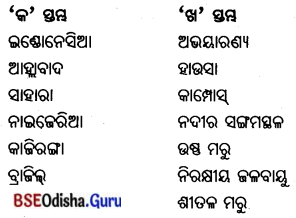
Answer:
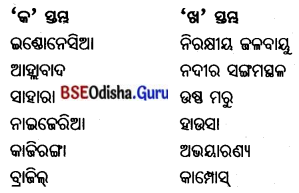
Question 2.
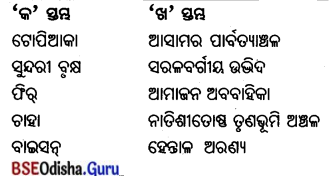
Answer:
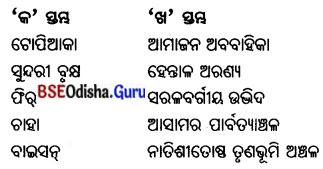
Question 3.
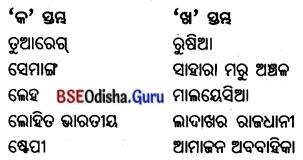
Answer:
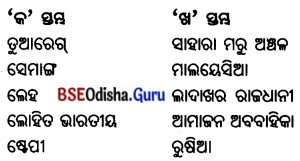
ପ୍ରଥମ ଯୋଡ଼ିକୁ ଦେଖୁ ଦ୍ଵିତୀୟ ଯୋଡ଼ି ପୂରଣ କର
1. ଆମାଜନ ଅବବାହିକା : ସ୍ମିଥ୍ ; ଗଙ୍ଗା-ବ୍ରହ୍ମପୁତ୍ର ଅବବାହିକା : ____।
Answer:
ଏକଶିଙ୍ଗା ଗଣ୍ଡା
2. ଷ୍ଟେପି ଅଞ୍ଚଳର ଅଧିବାସୀ : କିରଗୀଜ : : ପ୍ରେରି : ____।
Answer:
ଲୋହିତ ଭାରତୀୟ
3. ଇଣ୍ଡୋନେସିଆ : ନିରକ୍ଷୀୟ : : ସାହାରା : ____।
Answer:
ଉଷ୍ଣ ମରୁ
4. ରୁଷିଆ : ଷ୍ଟେପୀ : ଯୁକ୍ତରାଷ୍ଟ୍ର ଆମେରିକା : ____।
Answer:
ପ୍ରେରୀ

5. ଡାଉନ୍ସ : ଅଷ୍ଟ୍ରେଲିଆ : : ପମ୍ପାସ : ____।
Answer:
ଆର୍ଜେଣ୍ଟିନା
ମାନଚିତ୍ର ଅଧ୍ୟୟନ
1. ନିମ୍ନଲିଖତ ବିମାନ ବନ୍ଦରଗୁଡ଼ିକ ଦଶାଅ ।
(କ) ସାନ୍ତାକୁଜ ବିମାନ ବନ୍ଦର
(ଖ) ଥୁରୁଅନନ୍ତପୁରମ୍ ବିମାନ ବନ୍ଦର
(ଗ) ଧାମରା ବନ୍ଦର
(ଘ) ମିନାତ୍ମକମ ବିମାନ ବନ୍ଦର
(ଙ) ପାଲାମ ବିମାନ ବନ୍ଦର
(ଚ) ଦମ୍ଦମ୍ ବିମାନ ବନ୍ଦର
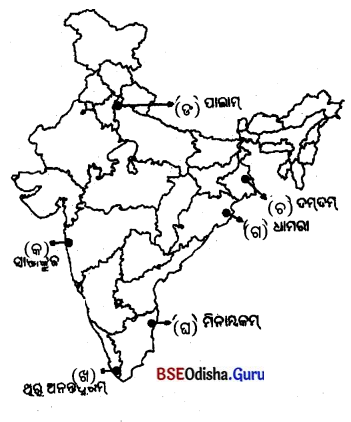
2. ମାନଚିତ୍ରରେ ସ୍ଵର୍ଷ ଚତୁର୍ଭୁଜ ଦର୍ଶାଅ ।
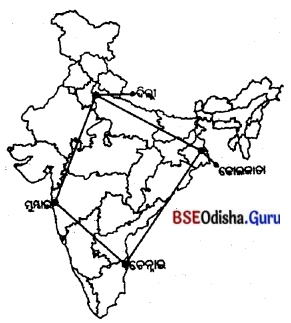
3. ନିମ୍ନଲିଖିତ ସ୍ଥାନଗୁଡ଼ିକ ଦର୍ଶାଅ ।
(କ) ମୁମ୍ବାଇ
(ଖ) କୋଲକାତା
(ଗ) ଦିଲ୍ଲୀ
(ଘ) ହାଇଦ୍ରାବାଦ
(ଙ) ଥୁରୁଅନନ୍ତପୁରମ୍
(ଚ) ଭୁବନେଶ୍ଵର
(ଛ) ବିଶାଖାପଟ୍ଟନମ୍
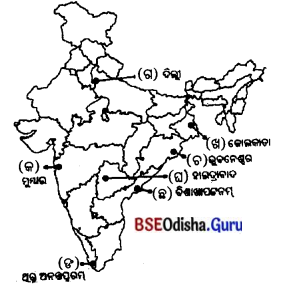
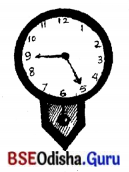

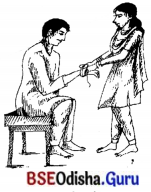
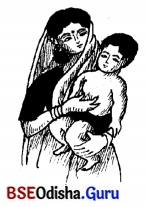
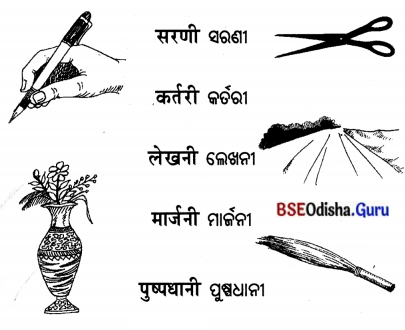
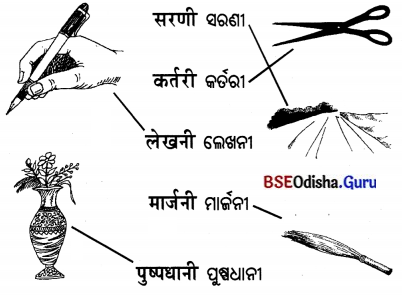
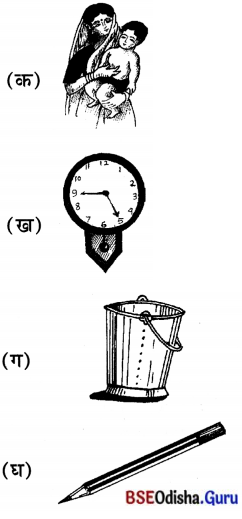
![]()
![]()
![]()
![]()
![]()
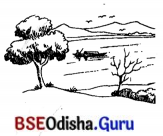
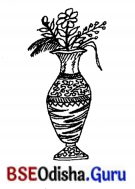
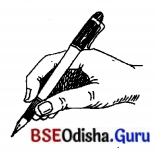






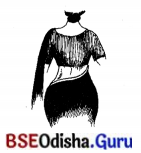
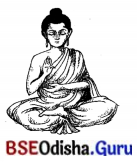
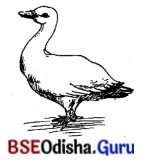
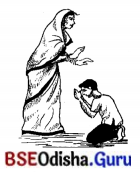
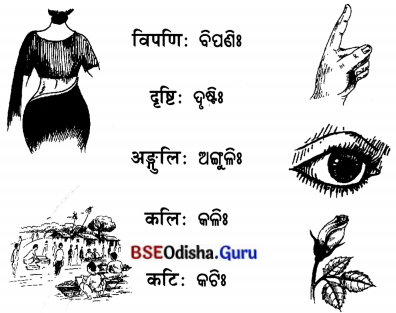
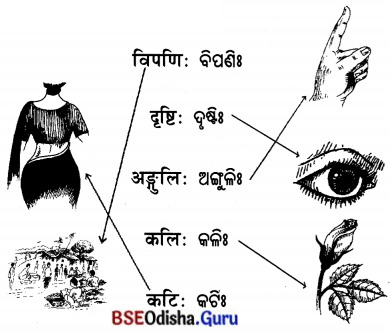
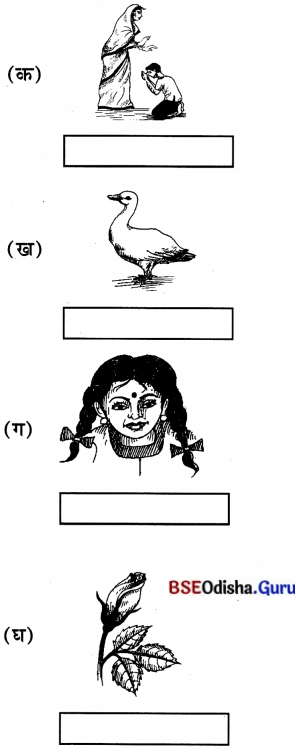

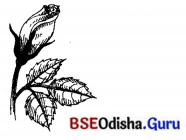
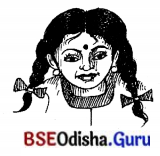
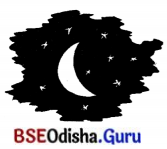
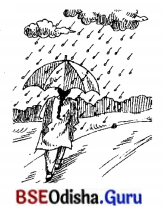
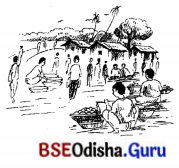
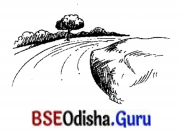
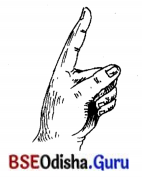
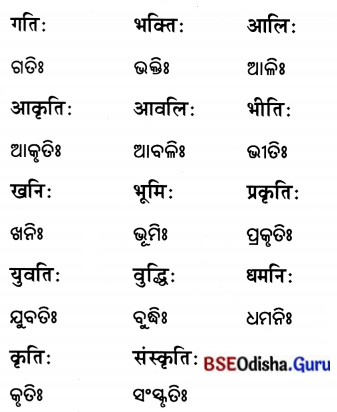
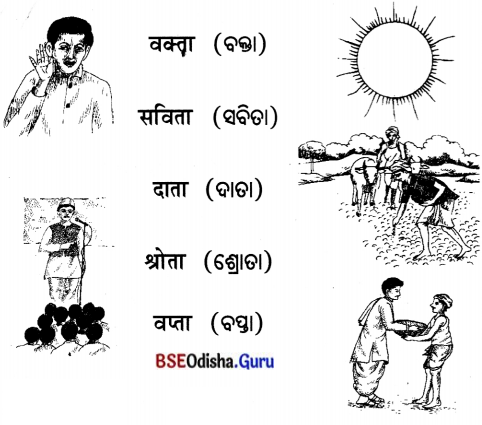
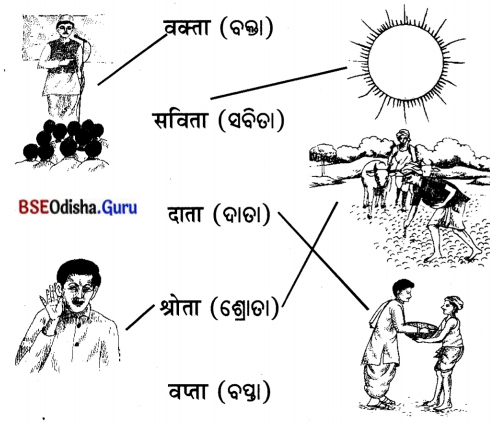
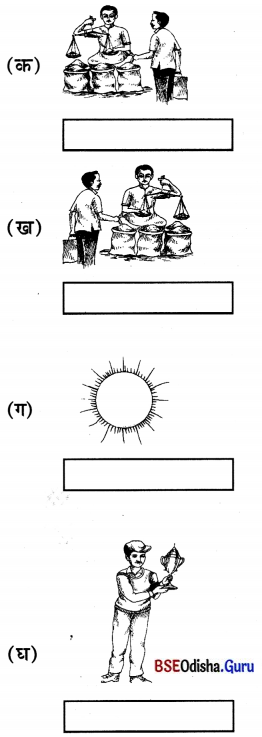
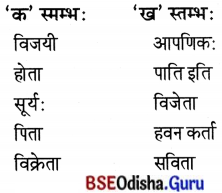
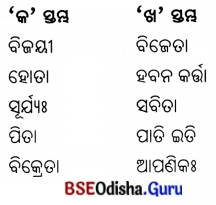
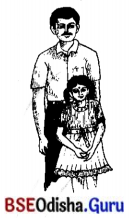 पिता (ପିତା) ବାପା
पिता (ପିତା) ବାପା